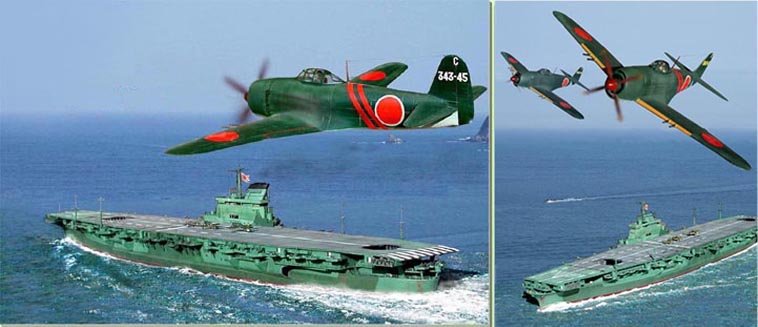


MARINA IMPERIALE
(IMPERIAL JAPANEESE NAVY)



KIDO BUTAI
CLASSE YAMATO
(YAMATO'S CLASS)
PORTAEREI SHINANO (信濃)
(AIRCRAFT CARRIER SHINANO)

STORIA (HISTORY)
Le navi da battaglia della classe Yamato programmate erano quattro, però solo due, Yamato e Musashi furono completate. La terza unità, Shinano, fu trasformata in portaerei durante la costruzione e fu pronta alla fine del 1944; la quarta nave non fu mai iniziata.
La progettazione di questa unità subì una sostanziale modifica perchè in origine doveva essere una nave appoggio aerei, sena una dotazione di apparecchi propri, destinata solo a trasportare combustibile e munizioni per gli aerei delle altre unità ed avere officine per ripararli. In seguito l'idea fu cambiata e l'unità ebbe un ponte di volo ed una aviorimessa per aerei propri, ma il loro numero fu assai limitato (furono infatti 47, cioè quanti ne potevano portare le portaerei leggere che dislocavano 15.000 tonnellate, contro le oltre 70.000 della Shinano). Statisticamente fu la più grande portaerei ad essere costruita negli anni della seconda guerra mondiale, superata solo nel 1955 dalla Classe Forrestal americana che dislocava 75.900 tonnellate ma in grado di portare 100 aerei.
Esternamente era simile alla Taiho, avendo un'isola sul lato destro con al suo interno un fumaiolo inclinato di 26° verso l'esterno. Era però larga ben 9 metri in più della collega giapponese. Ciò provocava una netta riduzione della velocità, 27 nodi, pur avendo lo stesso apparato motore della Taiho, che sviluppava invece ben 33 nodi.
Il ponte di volo aveva le dimensioni di m. 256x40 e si estendeva da prora a poppa estrema. La sua struttura faceva parte integrante di quella dello scafo sottostante ed era munita di due elevatori situati molto verso le estremità.
L'armamento era formato da 16 cannoni a.a. da 127 mm., disposti in otto complessi binati su otto plancette esterne al ponte di volo. Quelle sul lato destro erano più a poppavia di quelle sul lato sinistro, quasi sfalsate in successione a gruppi di due a destra e due a sinistra. Le 145 mitragliere da 25 mm. erano sistemate in 35 postazioni triple e 40 postazioni singole.
La corazzatura di murata aveva lo spessore di ben 203 mm., il ponte di volo era protetto da piastre dello spessore di 101 mm. e i depositi di munizioni avevano una protezione a murata di 178 mm.
Le caldaie e le macchine di propulsione erano quelle della Yamato così che la velocità risultava scarsa per una portaerei.
La Shinano fu impostata il 4 maggio del 1940 e la sua costruzione come corazzata continuò fino all'estate del 1941. Nel giugno del 1942 si decise di completarla come portaerei. Fu fatta galleggiare nel suo bacino di costruzione dell'Arsenale di kure dove avrebbe dovuto essere ultimata. Nel viaggio di trasferimento fu silurata dal sommergibile americano Archerfish (non erano state ancora completate molte paratie stagne!) ed affondò il 29 novembre del 1944.
The battle ships of the class programmed Yamatos were four, however only two, Yamato and Musashi were completed. The third unity, Shinano, was turned into aircraft carrier during the construction and it was ready at the end of 1944; the fourth ship was never iniziata.
The planning of this unity suffered a substantial change because in origin it had to be a tender airplanes, sena an endowment of proper instruments, destined only to transport fuel and ammunition for the airplanes of the other unities and possession shops to mend them. Subsequently idea was changed and the unity had a bridge of flight and a hangar for proper airplanes, but their number was limited a great deal (they were in fact 47, that is how much you/they could bring the light aircraft carriers that displaced 15.000 tons of it, against the over 70.000 of the Shinano). Statistically it was the greatest aircraft carrier to be built in the years of the second world war, old only in 1955 from the Class American Forrestal that displaced 75.900 tons but able to bring 100 aerei. s
Externally it was similar to the Taiho, having an island on the right side with to his/her inside a chimney tilted of 26° toward the outside. It was wide however well 9 meters in more than the Japanese colleague. This provoked a clean reduction of the speed, 27 knots, also having him/it same apparatus motor of the Taiho, that developed instead well 33 knots.
The bridge of flight had the dimensions of m. 256x40 and it extended him from bow to extreme stern. Its structure made integral part of that of the underlying hull and you/he/she was provided a lot of two situated elevators toward the extremities.
The armament was formed from 16 guns a.a. from 127 mms., prepared in eight complex binati on eight external plancettes to the bridge of flight. Those on the right side were more to poppavia of those on the left side, almost sfalsate in succession to groups of two to the right and two to the left. The 145 gunner from 25 mms. you/they were systematized in 35 triple postings and 40 single postings.
The corazzatura of bulwark had the thickness of well 203 mms., the bridge of flight was protected from plates of the thickness of 101 mms. and the deposits of ammunition had a protection to bulwark of 178 mms.
The boilers and the cars of propulsion were those of the Yamato so that speed resulted scarce for an aircraft carrier.
The Shinano was planned the 4 May of 1940 and his/her construction as armored it continued up to the summer of 1941. In the June of 1942 been decided to complete her as aircraft carrier. You/he/she was made to float in his/her basin of construction of the arsenal of kure where it would have had to be completed. In the trip of transfer you/he/she was torpedoed by the American submersible Archerfish (a lot of watertight paraties are not been completed! still) and it sank the 29 November of 1944.
PORTAEREI SHINANO (AIRCRAFT CARRIER SHINANO)
GIAPPONE (IMPERIAL JAPANEEESE NAVY)
PORTAEREI NELLA STORIA (AIRCRAFT CARRIER)